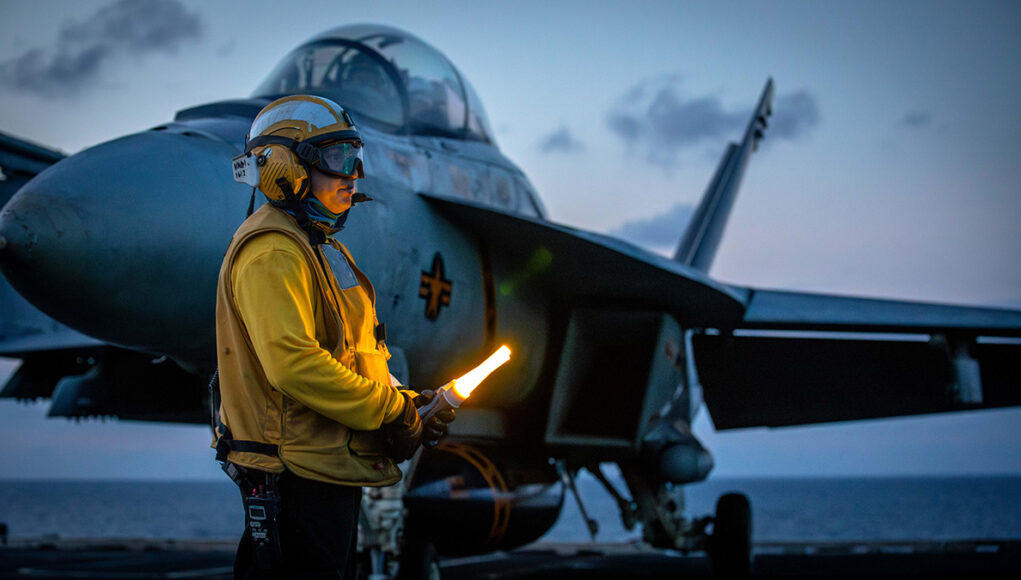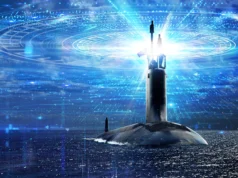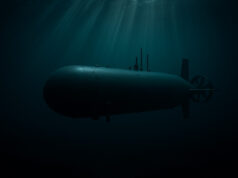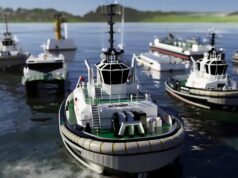The world’s largest aircraft carrier, USS Gerald R. Ford (CVN 78), has been conducting night flight operations in the Mediterranean Sea as part of its ongoing deployment with Carrier Strike Group 12, according to the U.S. Navy.
Photographs released by the Defense Visual Information Distribution Service (DVIDS) show Aviation Boatswain’s Mate (Aircraft Handling) 1st Class Sammie Smith directing an F/A-18E Super Hornet from Strike Fighter Squadron 31 during night operations on 10 October 2025. The aircraft were launched and recovered in darkness as the carrier continued its routine flight training and operational patrols across the U.S. Sixth Fleet’s area of responsibility.
The Gerald R. Ford, the first of its class, represents the most advanced and powerful carrier in service, designed to increase sortie generation rates, improve crew efficiency, and enhance the U.S. Navy’s ability to project air power globally. At over 1,090 feet long and displacing around 100,000 tons, it remains the largest warship ever built.
Carrier Strike Group 12’s deployment forms part of U.S. Naval Forces Europe-Africa’s continuous forward presence in the region. The Navy stated that the mission aims to “support the warfighting effectiveness, lethality and readiness of U.S. Naval Forces Europe-Africa, and defend U.S., Allied and partner interests in the region.”
The Gerald R. Ford features the U.S. Navy’s Electromagnetic Aircraft Launch System (EMALS) and Advanced Arresting Gear (AAG), both of which replace the steam catapult and traditional arresting wire systems used on previous Nimitz-class carriers.
Built by Newport News Shipbuilding, the Gerald R. Ford-class carriers will succeed the Nimitz-class as the U.S. Navy’s newest generation of nuclear-powered aircraft carriers. Each ship displaces approximately 100,000 tonnes at full load and measures between 1,092 and 1,106 feet in length, with a beam of 256 feet across the flight deck. Powered by two Bechtel A1B nuclear reactors, the class has an unlimited range and a service life of around 50 years. Designed for high efficiency, the ships feature 25 decks, four propeller shafts, and a top speed exceeding 30 knots.
The Ford-class supports over 75 aircraft and carries a combination of RIM-162 Evolved SeaSparrow Missiles, RIM-116 Rolling Airframe Missiles, Phalanx Close-In Weapon Systems, and Mk 38 machine gun mounts for close-range defence. Advanced radar systems, including the AN/SPY-6 active electronically scanned array, provide multi-domain situational awareness and threat tracking.
Ten Gerald R. Ford-class carriers are planned, with three currently under construction and one, CVN 78, fully operational as the flagship of the U.S. Navy’s global carrier fleet.














Somebody give Luke Skywalker a new Light Sabre 🤺
Still can’t launch or recover F35s yet!
It can if need be. There is nothing special about the F-35 in that regard. The Ford is an Atlantic carrier, the F-35 squadrons are being prioritized for the Pacific fleets for obvious reasons (china).
Possibly, but they’ve yet to start any EMALS trials with the F35. So if a conflict kicked off, there’d still be a delay before they cough be embarked on the Ford class.
Nothing “possibly” about it. Such a drama about nothing. In wartime they could and would be embarked as needed. The F35C and the Super Hornet are roughly the same weight. EMALS is a very easy to use system rated up to 100,000lbs launch weights, set the weights and thrust settings in the computer, off she goes. Only concern is probably melting the JBD’s and the wingtip clearances on parking spots/elevators/hangars, but who cares about that if the flag really goes up.
The static EMALS system at NAS Lakehurst has been launching F-35C since 2011. Your argument is moot.